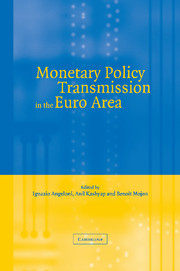 Monetary Policy Transmission in the Euro Area
Monetary Policy Transmission in the Euro Area Book contents
- Frontmatter
- Contents
- List of contributors
- Foreword by O. Issing
- Acknowledgements
- List of abbreviations
- Introduction
- Part 1 Macroeconometric evidence on the transmission mechanism in the euro area
- Part 2 Firms' investment and monetary policy: evidence from microeconomic data
- Part 3 The role of banks in the transmission: evidence from microeconomic data
- 14 Financial systems and the role of banks in monetary policy transmission in the euro area
- 15 The reaction of bank lending to monetary policy measures in Germany
- 16 Is there a bank-lending channel of monetary policy in Spain?
- 17 Is there a bank-lending channel in France? Evidence from bank panel data
- 18 Is there a bank-lending channel of monetary policy in Greece? Evidence from bank-level data
- 19 The Italian banking system and monetary policy transmission: evidence from bank-level data
- 20 The impact of monetary policy on bank lending in the Netherlands
- 21 The cross-sectional and the time dimension of the bank-lending channel: the Austrian case
- 22 The bank-lending channel of monetary policy: identification and estimation using Portuguese micro bank data
- 23 Transmission of monetary policy shocks in Finland: evidence from bank-level data on loans
- Part 4 Monetary policy in the euro area: summary and discussion of the main findings
- Appendix
- References
- List of figures
- List of tables
- Subject index
- Author index
22 - The bank-lending channel of monetary policy: identification and estimation using Portuguese micro bank data
Published online by Cambridge University Press: 22 September 2009
- Frontmatter
- Contents
- List of contributors
- Foreword by O. Issing
- Acknowledgements
- List of abbreviations
- Introduction
- Part 1 Macroeconometric evidence on the transmission mechanism in the euro area
- Part 2 Firms' investment and monetary policy: evidence from microeconomic data
- Part 3 The role of banks in the transmission: evidence from microeconomic data
- 14 Financial systems and the role of banks in monetary policy transmission in the euro area
- 15 The reaction of bank lending to monetary policy measures in Germany
- 16 Is there a bank-lending channel of monetary policy in Spain?
- 17 Is there a bank-lending channel in France? Evidence from bank panel data
- 18 Is there a bank-lending channel of monetary policy in Greece? Evidence from bank-level data
- 19 The Italian banking system and monetary policy transmission: evidence from bank-level data
- 20 The impact of monetary policy on bank lending in the Netherlands
- 21 The cross-sectional and the time dimension of the bank-lending channel: the Austrian case
- 22 The bank-lending channel of monetary policy: identification and estimation using Portuguese micro bank data
- 23 Transmission of monetary policy shocks in Finland: evidence from bank-level data on loans
- Part 4 Monetary policy in the euro area: summary and discussion of the main findings
- Appendix
- References
- List of figures
- List of tables
- Subject index
- Author index
Summary
Introduction
This chapter investigates the existence of the bank-lending channel in the transmission of monetary policy using Portuguese micro bank data. In contrast to the conventional approach, which addresses the identification issue by resorting to reduced form equations for bank credit with variables in differences, we directly estimate loan-supply schedules with variables in levels, thereby exploiting recent results on cointegration for panel data.
The main conclusion is that there is a banking lending channel in the transmission of monetary policy in the Portuguese economy and that the importance of this channel is larger for the less capitalised banks. Size and liquidity do not appear to be relevant bank characteristics in determining the importance of the lending channel.
The remainder of the chapter is organised as follows. Section 2 briefly characterises the main changes undergone by the Portuguese banking sector during the 1980s and 1990s. Section 3 describes the new approach aimed at identifying and estimating the importance of the bank-lending channel. Section 4 reports the empirical results for Portugal and section 5 summarises the main conclusions.
Monetary policy and banking sector developments in Portugal during the 1990s
Since the early 1980s the Portuguese financial system underwent a fundamental liberalisation process beginning with the opening up of the banking sector to private initiative in 1983. In this period the first steps towards the elimination of the administrative controls on interest rates and credit growth were also taken.
- Type
- Chapter
- Information
- Monetary Policy Transmission in the Euro AreaA Study by the Eurosystem Monetary Transmission Network, pp. 359 - 371Publisher: Cambridge University PressPrint publication year: 2003
- 7
- Cited by
